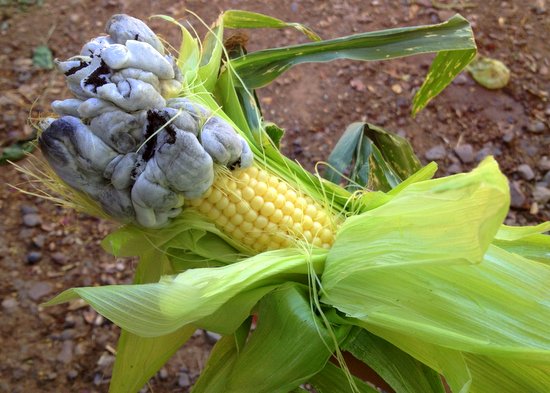Kind of like a mushroom, huitlacoche is a naturally occurring parasitic fungus that grows on untreated organic corn.
I’ve shared some of mine in this column: mussels, liver, lengua (tongue), sesos (brains). Here’s another one: huitlacoche (whee-tla-KO-cheh). Corn “smut.” Mexican truffles. Kind of like a mushroom, it’s a naturally occurring parasitic fungus that grows randomly on untreated organic corn.
“You won’t even know it’s in there,” said a friend — and she was right. The deep-fried quesadillas I ordered, with shrimp, huitlacoche and Oaxaca cheese, were delicious, the huitlacoche a smoky, earthy, soft complement to the other ingredients. Cooked, the unpalatable grey turns to a deep-black brown which, while unusual, doesn’t have the same repellant effect as elephant-skin grey. Consider me a new fan! Huitlacoche is used as a filling or topping in many classic Mexican dishes, including this gordito.
Huitlacoche is used as a filling or topping in many classic Mexican dishes, including this gordito.
Huitlacoche can be used anywhere you’d use mushrooms and is most commonly sautéed with onions, chiles and garlic and used in quesadillas, tortas, tamales, stews and soups. It pairs well with eggs and is a flavorful addition to scrambled eggs, frittata or omelets. When cooked, huitlacoche releases an inky black liquid, almost like a gravy. Cooking it longer will cause some of this to evaporate, depending on the texture you’re looking for.
If you’re lucky, you might find a farmer or vendor selling whole ears of corn with huitlacoche “attached.” If you do, remove the husks and any hair. Use a sharp knife to carefully cut off the huitlacoche, rinse gently, pat dry and proceed with your recipe.